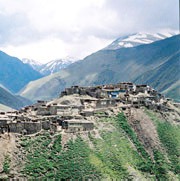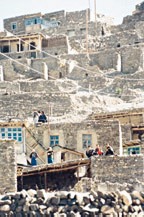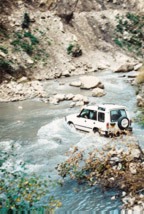|
Summer 1998 (6.2) Khinalig by Gulnara Mehmandarova, Photos by Farid Mammad
f you want to visit Khinalig, make sure you come in summer, as this remote Caucasus mountain village is inaccessible most of the year. They say the best transport to the village is by horseback through canyons from the southeast. Even when the roads are passable, you'll need to go by jeep along dizzying precipices, ravines and canyons. The trip is not for the faint-hearted; it's actually quite risky, but most people who venture it consider the journey worthwhile. At the top of the mountain, you'll find an isolated village with houses built on top of each other. In fact, the roofs of houses on the lower levels serve as the courtyards and gardens to the ones above. Natives speak a little known, unwritten language and call their village, "Ketsh" and their language "Ketsh mitsl," according to Caucasus specialist Y. Dasheriyev. It seems that in the past, their old village was destroyed by an earthquake and survivors settled down where they began cultivating henna, "khina" in Azeri, and thus the name-Khinalig. The village is located 60 km southwest of Guba at an elevation of 2,100 meters, making it safe from would-be invaders. Rugged cliffs of limestone and granite cut the village off from any enemy, not to mention the rest of civilization.
Khinalig's original defense system consisted of fortress walls and towers. The walls have not been preserved, but you can still see the evidence of one crumbling pyramid-like watchtower. Older villagers believe that the tower was also used as a temple for an ancient fire worship cult. The language spoken by the Khinalig people is peculiar because it bears no resemblance to the languages spoken in nearby villages. It is believed to be related to a family of languages spoken in Daghestan [formerly part of Azerbaijan but located in present-day Russia]. An estimated 2,000 people are native speakers. It is assumed that the people of Khinalig are descendants from the old tribes of Albania, the ancient name of present-day Azerbaijan, but which bears no known relation to the other Albania in Europe. Not only do the people speak differently in Khinalig, they don't look like typical Azeris either. The are quite tall with sturdy builds. Many are fair-haired and have gray or blue eyes. Life in Khinalig Many traditional Khinalig homes have only one room. In those which have two stories, the first floor is used for household needs, and the second one for living. The majority of houses have no windows, just holes in the ceiling that allow light to come through. Often, the roof is used as a path or sidewalk by the neighbors directly above. In this way, houses are built like terraces against the mountainside. Take Mirza Malikov's house, for instance. Its simple one-room building has a staircase that leads to an open verandah. In the roof are two holes that allow light in and smoke out. The walls are plastered and white-washed, and fit the house's modest interior. Shelves all along the walls hold bedclothes, pots, plates, dishes, and containers of flour and grain. A "tunor" (the Khinalig word for oven) sits in the middle of the room and is used to bake bread, cook, and heat the house. The Malikov family often gathers around the tunor to eat and warm themselves. Another common sight inside Khinalig houses centers around the carpet loom. Girls learn carpet-making from childhood. According to tradition, each girl must make carpets, mats and other articles for her dowry to take with her when she sets up her own household. The people get their water from a spring "Khanjal Bulaghy (Dagger spring) which is about a kilometer away from the village. Water runs by gravity through a 20-30 cm canal and branches into three arms by special ceramic pipes. The water is cold, pleasant tasting and good for drinking. Khinalig "Must-Sees" Mosques in Khinalig look much like the houses, except that they are larger; they do not have minarets. The Joma {Friday} mosque is the largest, and was renovated in 1968. The mosque in the Gamk quarter is curious because it features a narrow adjoining room called a "zulmatkhana." A wrongdoer would spend time there in order to be relieved of his sin. This practice is not common in Islam, which indicates that it was possibly a belief preserved from an earlier religion. In the Sheikh Shalbuzbaba mosque, make sure to look for the carved wooden column that features older local art. (The other columns had to be reconstructed, only one of the original columns remains.) The people of Khinalig, like
those in other places throughout Azerbaijan, pay great attention
to welcoming guests, infrequent as they may be. They are known
for extending warm hospitality to those who dare to make the
difficult trip. |





